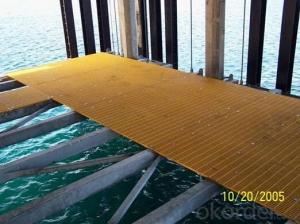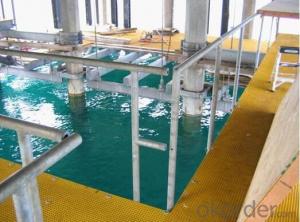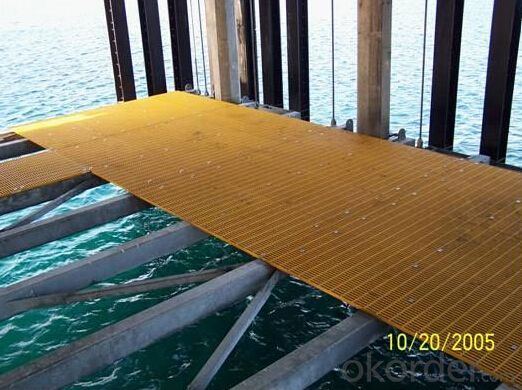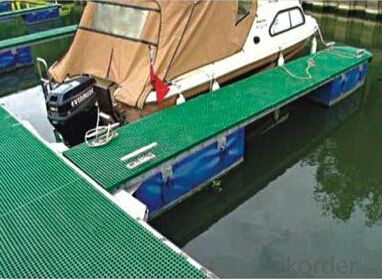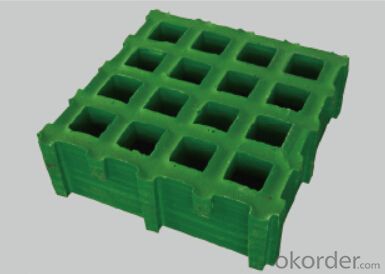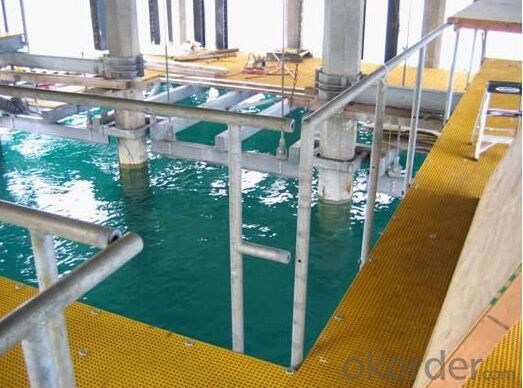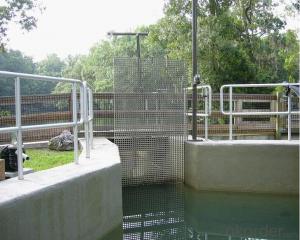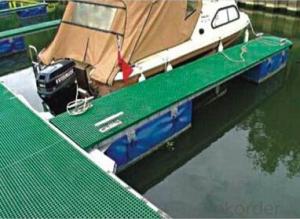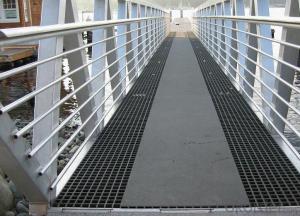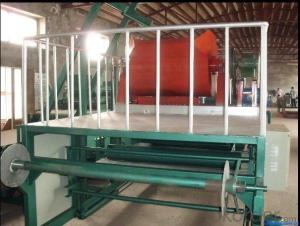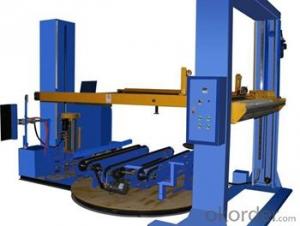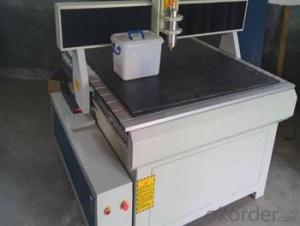FRP Pultrusion Profiles Anti-Slip Moulded Grating 2024 New Products
- Loading Port:
- Shanghai
- Payment Terms:
- TT OR LC
- Min Order Qty:
- 10 pc
- Supply Capability:
- 8000 pc/month
OKorder Service Pledge
OKorder Financial Service
You Might Also Like
Specification:
FRP molded grating made of vertical and horizontal continuous fiberglass fully soaked in unsaturated polyester resin giving perfect bi-directional mechanical properties. Combining unmatched corrosion resistance with strength, long life and safety, molded grating provide the ultimate in reliable performance, even in the most demanding corrosive conditions. Besides, it is easy to cut and install. CNBM offer the widest selection with panel sizes, colors and slip resistant surfaces, clients can avail FRP grating your specific requirements.
Product Features:
- Light but high loaded strength
- High anti-corrosion and anti-aging
- Easy installation and maintenance
- Low maintenance
- Non-conductive
- Lowest in life cycle cost
- Corrosion Resstance
- Anti-slippery
- Various sizes and color available
Colour Design:
To satisfy customer's design project, CNBM grating offers a wide selection of grating colors to choose from. The standard colors available for fiberglass grating as following:
- Blue
- Red
- Yellow
- Green
- Light Grey
- Dark Grey
Custom colors of fiberglass grating may be available upon request, you can contact us learn more.
Moded Grating Sizes List:
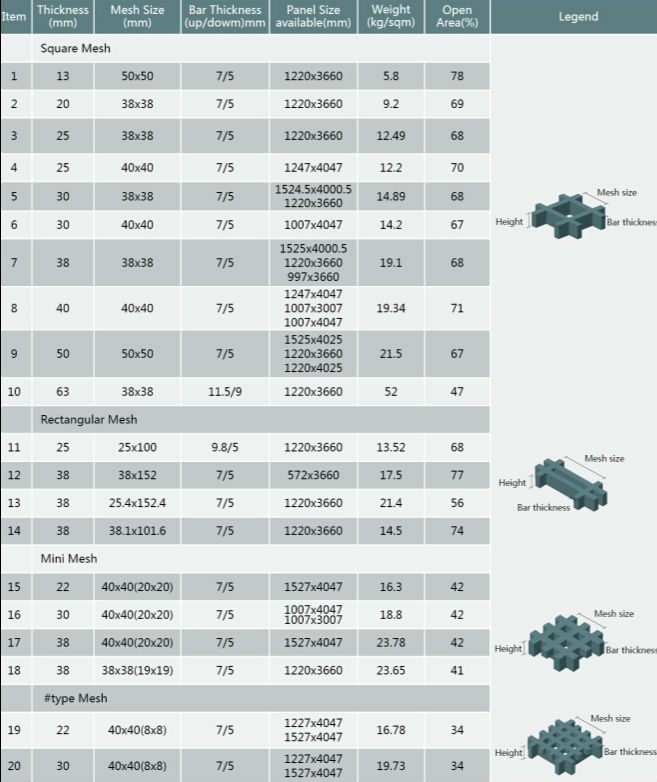
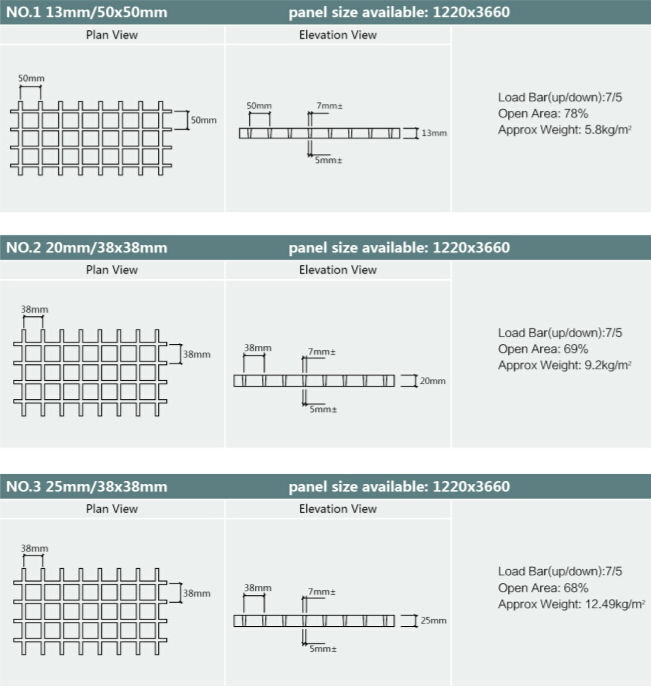

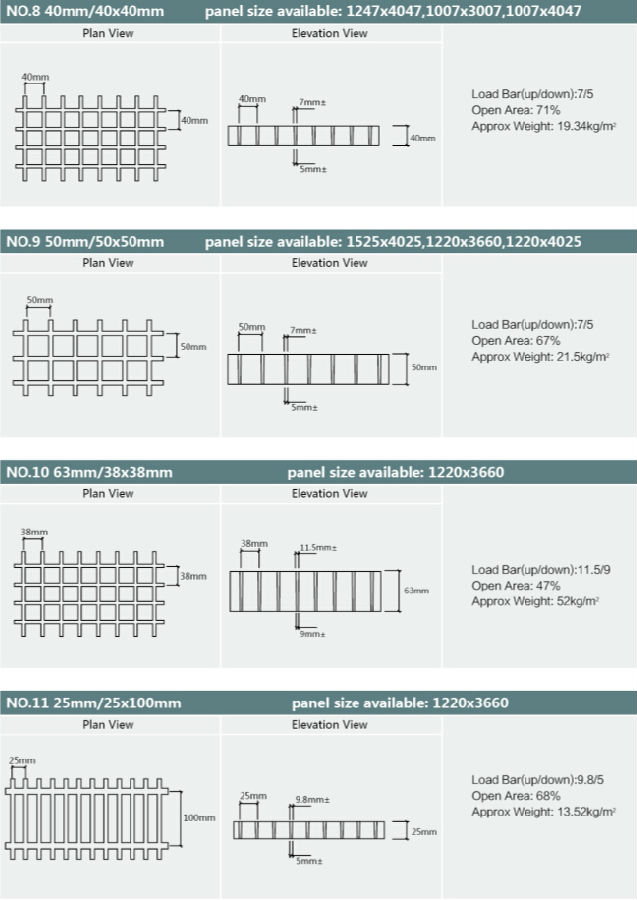
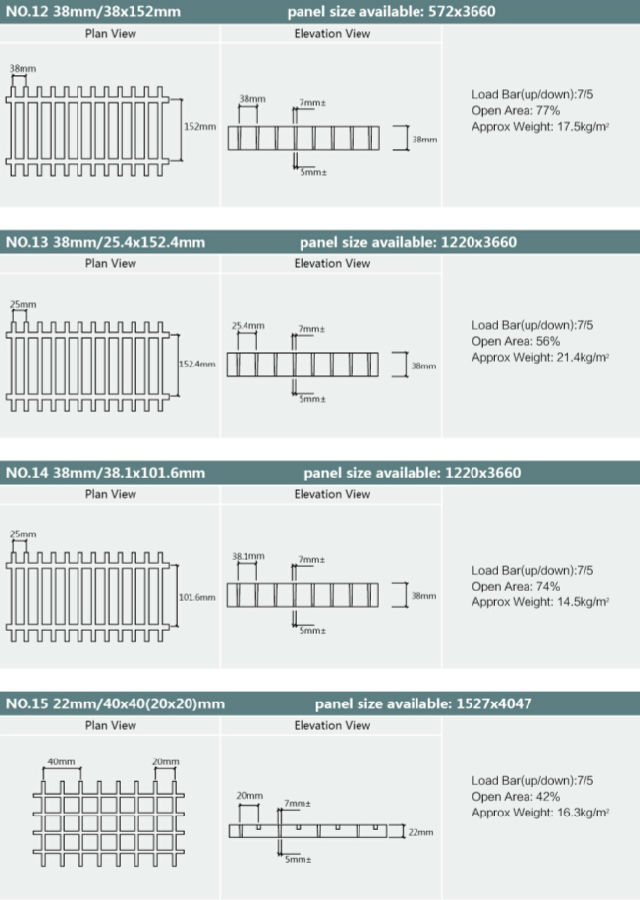

- Q: Can FRP pultrusion profiles be used in aerospace applications?
- FRP pultrusion profiles are applicable in aerospace applications. They possess numerous advantages that render them suitable for use in this field. Firstly, their exceptional strength-to-weight ratios are crucial in the aerospace industry as they contribute to weight reduction and fuel efficiency improvement. Secondly, FRP materials display high resistance to corrosion, making them suitable for enduring exposure to harsh environments like high altitudes and extreme temperatures. Additionally, FRP pultrusion profiles provide design flexibility, allowing for the production of intricate shapes and geometries. This flexibility enables aerospace engineers to customize the profiles according to specific requirements and optimize their performance. Moreover, FRP materials exhibit low thermal conductivity, which aids in insulation applications and minimizes heat transfer. Lastly, FRP pultrusion profiles have demonstrated commendable fatigue resistance, a crucial factor for aerospace applications subjected to cyclic loading. Overall, these properties establish FRP pultrusion profiles as a viable option for various aerospace components, including structural members, interior parts, and electrical enclosures.
- Q: Are FRP pultrusion profiles resistant to chemicals used in food packaging?
- FRP pultrusion profiles have proven to be highly resistant to chemicals typically employed in the realm of food packaging. Their remarkable ability to withstand a vast array of chemicals, including acids, bases, solvents, and oils, is well-documented. Consequently, FRP pultrusion profiles are a fitting option for applications that necessitate interaction with food packaging materials. Nevertheless, it is crucial to acknowledge that the chemical resistance of FRP profiles may differ based on the formulation and type of resin utilized. Consequently, it is prudent to seek guidance from the manufacturer or supplier to ensure that the chosen FRP pultrusion profiles are compatible with the specific chemicals employed within the food packaging industry.
- Q: Can FRP pultrusion profiles be used in the construction of recreational vehicles (RVs)?
- Yes, FRP (Fiber Reinforced Polymer) pultrusion profiles can be used in the construction of recreational vehicles (RVs). FRP pultrusion profiles are known for their high strength-to-weight ratio, corrosion resistance, and durability, making them an ideal material for various applications, including RV construction. RVs require lightweight yet strong materials to ensure fuel efficiency and structural integrity. FRP pultrusion profiles meet these requirements as they are lightweight, yet have high tensile strength and stiffness. This allows for the construction of RVs that are strong and durable, while also being lightweight and easy to tow. In addition, FRP pultrusion profiles have excellent resistance to environmental factors such as moisture, UV radiation, and chemicals. This makes them suitable for outdoor applications, including RVs, where they will be exposed to various weather conditions. Furthermore, FRP pultrusion profiles can be easily customized and molded into various shapes and sizes, allowing for the design flexibility required in RV construction. They can be used for structural components such as frames, chassis, and supports, as well as for interior and exterior panels, floors, and roofs. Overall, the use of FRP pultrusion profiles in the construction of recreational vehicles offers numerous advantages, including strength, durability, lightweight, and resistance to environmental factors. These characteristics make FRP pultrusion profiles a reliable choice for RV manufacturers looking to build high-quality, efficient, and long-lasting vehicles.
- Q: Can FRP pultrusion profiles be used in infrastructure projects?
- Yes, FRP pultrusion profiles can be used in infrastructure projects. These profiles are lightweight, durable, and corrosion-resistant, making them ideal for applications in bridges, walkways, railings, and other structural components. They offer high strength-to-weight ratios and can be customized to meet specific project requirements. Additionally, FRP pultrusion profiles are non-conductive, making them suitable for electrical infrastructure projects.
- Q: Are FRP pultrusion profiles resistant to moisture or humidity?
- Yes, FRP (Fiber Reinforced Polymer) pultrusion profiles are highly resistant to moisture and humidity. The pultrusion process involves impregnating continuous fibers with a polymer resin, resulting in a strong and durable composite material. This composite is inherently moisture-resistant and does not absorb water like traditional materials such as wood or metal. Additionally, FRP pultrusion profiles have a low coefficient of thermal expansion, meaning they are less likely to expand or contract under varying levels of humidity. This resistance to moisture and humidity makes FRP pultrusion profiles suitable for a wide range of applications, including outdoor structures, marine environments, and other moisture-prone areas.
- Q: What raw materials do FRP pultrusion require?
- Resin: commonly used unsaturated polyester resin, epoxy resin, vinyl ester resin, phenolic resin;
- Q: Can FRP pultrusion profiles be used in the mining and mineral processing industry?
- The mining and mineral processing industry can indeed utilize FRP (Fiber Reinforced Polymer) pultrusion profiles. These profiles possess multiple properties that render them suitable for application in this industry. To begin with, FRP pultrusion profiles are characterized by their lightweight yet remarkably strong composition. This quality makes them ideal for situations where weight reduction holds significance, such as in mining equipment or processing plants. Despite their lightweight nature, FRP profiles can endure substantial loads and withstand corrosion. This is particularly advantageous in the mining industry, where equipment is exposed to harsh environments and corrosive substances. Furthermore, FRP pultrusion profiles are non-conductive with exceptional electrical insulation properties. This proves beneficial in mining and mineral processing operations, where electrical safety takes precedence. FRP profiles can be utilized in scenarios where electrical conductivity must be avoided, such as in electrical enclosures or cable trays. Moreover, FRP pultrusion profiles exhibit high chemical resistance, including resistance to acids and alkalis. This renders them suitable for deployment in mineral processing plants, where various corrosive chemicals are employed in mineral extraction and processing. FRP profiles can withstand exposure to these chemicals without deteriorating or sustaining significant damage, consequently increasing their lifespan and reducing maintenance costs. Additionally, FRP pultrusion profiles possess a high strength-to-weight ratio, enabling the construction of durable and lightweight structures. This proves particularly advantageous in mining operations, where structures like walkways, ladders, and platforms need to be installed in challenging terrains. The lightweight nature of FRP profiles facilitates easier transportation, handling, and installation compared to traditional materials like steel. In conclusion, FRP pultrusion profiles offer a viable option for various applications in the mining and mineral processing industry due to their lightweight composition, high strength, corrosion resistance, electrical insulation, and chemical resistance properties. These profiles present numerous advantages over traditional materials, making them a feasible choice for implementation in this industry.
- Q: Are FRP pultrusion profiles resistant to automotive fluids?
- Yes, FRP pultrusion profiles are generally resistant to automotive fluids. FRP stands for Fiber Reinforced Polymer, which is a composite material made up of a combination of fibers and a polymer matrix. The fibers used in FRP, such as fiberglass, carbon, or aramid, provide excellent resistance to many automotive fluids, including oils, fuels, and coolants. The polymer matrix used in FRP profiles is typically a thermosetting resin, such as polyester, vinyl ester, or epoxy. These resins are known for their chemical resistance properties, making FRP pultrusion profiles highly resistant to a wide range of automotive fluids. They can withstand exposure to various fluids without experiencing significant degradation or loss of mechanical properties. It is important to note that the specific resistance of FRP pultrusion profiles to automotive fluids may vary depending on the type of resin used and the specific composition of the composite material. Therefore, it is recommended to consult with the manufacturer or supplier of the FRP profiles to ensure they are suitable for the intended application and the specific automotive fluids they will be exposed to.
- Q: Are FRP pultrusion profiles resistant to chemicals used in food processing?
- Yes, FRP (Fiber Reinforced Plastic) pultrusion profiles are highly resistant to chemicals used in food processing. They are specifically engineered to withstand harsh chemical environments, including the cleaning and sterilization agents commonly used in food processing facilities. This resistance makes FRP pultrusion profiles a suitable material choice for various applications in the food industry where chemical resistance is crucial.
- Q: Can FRP pultrusion profiles be used in the production of electrical insulators?
- Yes, FRP (Fiber Reinforced Polymer) pultrusion profiles can be used in the production of electrical insulators. FRP pultrusion profiles are known for their excellent electrical insulation properties, making them suitable for a wide range of electrical applications. The high-strength and non-conductive nature of FRP materials make them ideal for insulating components in electrical systems, including insulators. FRP pultrusion profiles are made by impregnating continuous fibers, such as fiberglass, carbon fiber, or aramid, with a polymer resin, which is then cured and shaped using the pultrusion process. This results in a durable and lightweight material that offers excellent electrical insulation properties. Electrical insulators are used to prevent the flow of electric current between conductive materials or components. They are essential in electrical systems to maintain safety and prevent electrical leakage or short circuits. FRP pultrusion profiles can be designed and manufactured to meet the specific requirements of electrical insulators, including dimensional accuracy, mechanical strength, and electrical insulation performance. Additionally, FRP pultrusion profiles offer several advantages over traditional materials like wood, porcelain, or ceramics. They are corrosion-resistant, have a high strength-to-weight ratio, and can be easily customized to meet the specific needs of electrical insulator applications. FRP pultrusion profiles are also non-conductive, which is a crucial factor for electrical insulation. Overall, FRP pultrusion profiles are highly suitable for the production of electrical insulators due to their excellent electrical insulation properties, durability, lightweight, and customization options.
Send your message to us
FRP Pultrusion Profiles Anti-Slip Moulded Grating 2024 New Products
- Loading Port:
- Shanghai
- Payment Terms:
- TT OR LC
- Min Order Qty:
- 10 pc
- Supply Capability:
- 8000 pc/month
OKorder Service Pledge
OKorder Financial Service
Similar products
Hot products
Hot Searches
Related keywords
